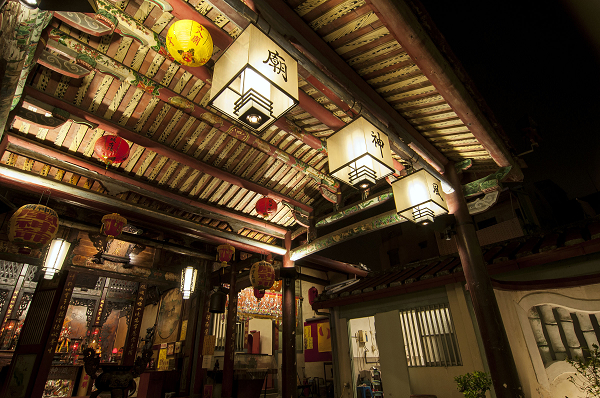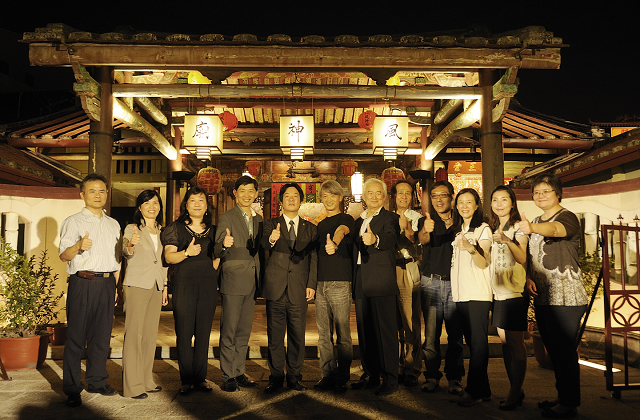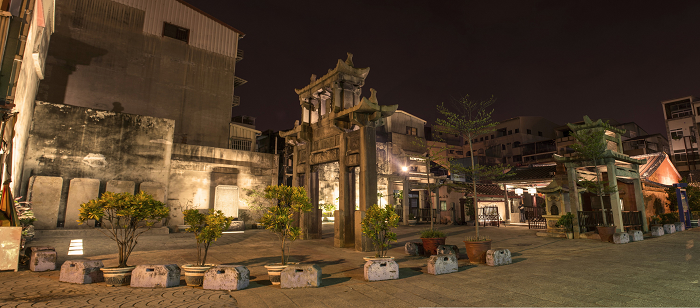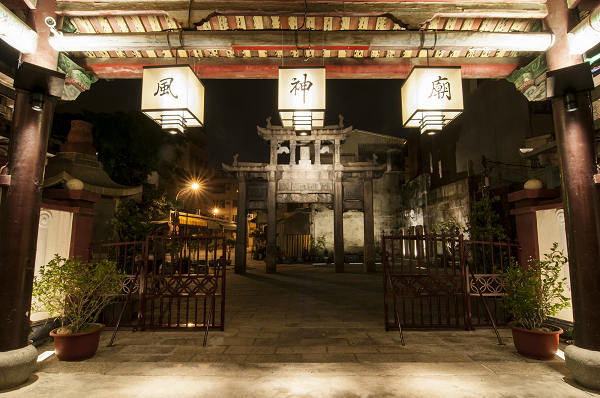Temple of Light Creates New Domain for Lighting Applications
Through lighting design, the “Temple of Light” illuminates the harmonious beauty of a historic shrine
2013/12/20 | By Michelle HsuThe “Temple of Light,” a result of collaboration between Tainan City Government’s Cultural Affairs Bureau and the Coretronic Culture and Arts Foundation (CCAF), formally lit up in mid-September, 2013 year after two years of planning and preparation.
The Temple of Light is actually the historic Wind God Temple, the only shrine in Tainan devoted primarily to the worship of the Wind God, transformed through lighting design into an art work of harmonious beauty. This creative achievement opens a new domain for the application of artificial lighting.
The temple is located in a quiet lane off Shennong Street, though its address is actually on Lane 143 of Minquan St. In front there is an Official Reception Arch, where officials sent to Taiwan by the Qing court were welcomed by local dignitaries. Like the original temple, the arch was built in1739 AD. The two structures are listed by the government as third-class historic sites.

Aesthetic Lighting
The CCAF was founded by the Coretronic group at the end of 2010 with the aim of building a “lighting and cultural art platform” to bring together professionals from different fields with leaders of the art and culture community to promote the artistic application of lighting. The foundation exemplifies the spirit of the Coretronic Corp., which is positioned as an innovative optical display solution provider, and its enthusiasm for artistic lighting display.
For its “Temple of Light” program, the foundation invited internationally renowned lighting designer Chou Lien to plan the esthetic lighting for Taiwan’s first “Temple of Light.”
Prior to the “relighting,” the temple courtyard was illuminated at night only by a street lamp and the temple itself only by a fluorescent light, giving a cold and uninviting appearance. Now the “Temple of Light” exudes an entirely new atmosphere that lets visitors feel its warmth and historical value. The new lighting design has gotten rid of the glare of the old lighting while highlighting the surrounding natural environment and its historical and cultural characteristics.
Chou Lien, who heads up the “Temple of Light” program, was born in 1944 in Chengdu, China. He is CEO of the well-known American architectural lighting design firm Brandston Partnership Inc. (BP), and also serves as lighting design and energy efficiency planning consultant for Taiwan’s Industrial Technology Research Institute (ITRI). “Lighting is a field of professional knowledge that not only deals with what we can see, but is also closely related to the quality of human life,” Chou remarked.

“Subtraction” Techniques
In his lighting design for the Wind God Temple Chou used the concept of “subtraction,” removing the temple’s original spiral fluorescent light tube and then adding an appropriate degree of lighting focused on the inscribed tablets and the main part of the temple building. To add allure to the temple courtyard, Chou removed the street lamp and replaced it with a projection lamp beaming upward from the ground. A beam of light shining on the stone bell tower at night makes the temple appear bright, tranquil, and dignified. At the same time, projecting lights placed in the eaves of the stone bell tower cast their beams toward the reception arch, giving a layered appearance to the red mud walls on both sides of the main building and producing an integrating effect with the surrounding environment.
Chou describes this technique as “adding light and hiding light.” Following the lighting transformation, the temple’s interior, exterior, and courtyard have been brightened up, lending a solemn beauty to the complex.

Continuity
CCAF chairman Yao Cheng Chung remarked, “Different local governments often try to attract tourists by arranging a variety of activities designed to forge an image of a creative city. These activities, such as fireworks displays, lack continuity; after the fireworks are spent, everything returns to normal.” Yao urges the governments of cities and counties to spend more time thinking about this and planning new programs that highlight and enhance local culture and scenery. In this way, the governments can both restore original values and create new possibilities.
The “Temple of Light” program is a good example of how this can be done. It uses the design of light to help the Wind God Temple, with its almost 300 years of history, re-emerge as a cultural landmark from the Qing Dynasty. This also brings people closer to culture in their daily lives and strengthens their pride in Taiwan’s existing culture.
Following the formal lighting ceremony, the CCAF “adopted” the temple and will use it as a base for protecting the lighting environment, collecting and digitizing historical data, and collaborating with local cultural groups to organize activities for the “Temple of Light.” It will share the experience of its cooperative project with the Tainan City Government with other organizations around the island.
According to the Tainan City Government’s Cultural Affairs Bureau, the “Temple of Light” program has the full support of the city administration as part of its “lighting-up Tainan” plan.

A Model of Lighting Esthetics
The temple’s function as the gateway to Taiwan for Qing Dynasty officials was lost during the era of Japanese rule (1895-1945). The Japanese demolished part of the temple and arch to facilitate construction of the first planned road in Taiwan, Minquan Road. In 1924 the local people raised funds to rebuild the temple and welcome back the Wind God. The structures were further renovated after Taiwan was restored to Chinese administration, but the temple remained smaller than it once was.
Chiang Hsun, a scholar of aesthetics, suggests that when tourists visit the temple they imagine this situation: Qing Dynasty officials arriving in Taiwan, disembarking on the South River docks, and passing through the towering archway with its four Chinese characters “Ao Zhu Qing Tian” (literally meaning “giant pillars holding up the sky”).
The officials would be in a state of shock after having just managed to cross the perilous Black Trench (the Taiwan Straits), so they would naturally go straight to the Wind God and thank him for his protection during their trip; only then would their minds be at ease. Officials whose terms of duty in Taiwan were coming to an end would be keen to ask the Wind God to grant them a safe and pleasant journey back home to China.
This is an accurate depiction of the historical significance of the Wind God Temple in the development of Taiwan. Tainan, with its 22 national historic sites and innumerable old streets and ruins, is symbolic of the early years of Taiwan’s history. Rich in culture, the city attracts over seven million visitors a year. The CCAF and the city government collaborated in developing the “Temple of Light” as the first step in their efforts to light up the city’s rich array of historic sites so as to enliven the night-time cityscape and allow people to be guided by light and shadow into a dialogue with history.
The CCAF began promoting the “Light Environment Movement” in 2011 in the hope of drawing public attention to “lighting” aesthetics and prompting the people to think about how to make better use of it, avoid the unnecessary waste of resources, and build a better living environment for the next generation.
By organizing more than 20 optical display performances, light work camps, light aesthetics seminars, and other activities around Taiwan over the past two years, the foundation has enlisted 20,000 people into the ranks of its Light Environment Movement. Last year the foundation selected Tainan as the starting point for the promotion of its “Let’s Sense Light Tainan” program, and invited Chou Lien to serve as a consultant for the first long-term exploration of the light environment of urban spaces.
The foundation hopes that its efforts will lead to the creation of places where the public can directly experience Tainan’s culture and history as illuminated by esthetic urban lighting, and to the establishment of Taiwan as a model for the application of lighting esthetics throughout Taiwan.

